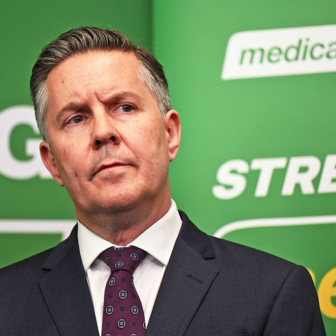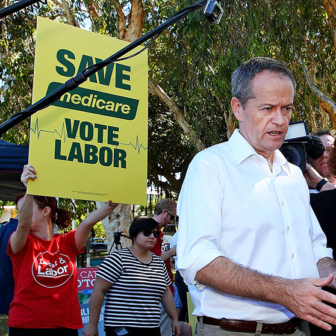“Dora and Andrew Arkalis will never forget receiving the news,” began a recent article on childhood cancer in the Age. The couple had taken their four-year-old son, Michael, to the Royal Children’s Hospital to have recurring headaches diagnosed, and a registrar brought them a scan of their boy’s head. “The doctor said, ‘Michael’s got a brain tumour. It’s the size of a golf ball: we don’t know what sort of tumour it is, we don’t know if it’s aggressive, but we think it’s inoperable.’ He said it just like that,” Andrew told the newspaper.
What Andrew Arkalis describes is not unusual. Search the internet and you’ll find similar stories. “I wouldn’t touch her with a ten-foot stick,” one distressed mother recalled being told by an orthopaedic surgeon about her chronically ill daughter. “Isn’t it well known that you don’t deliver bad news on a Friday afternoon?” wrote another woman, Lisa, after her husband was given the diagnosis of motor neurone disease – an incurable disorder of the nervous system – on the Friday before a long weekend. With an appointment to see the neurologist the following Tuesday to discuss the possibility of counselling, Lisa and her husband went home, shocked and unsupported, to spend “the blackest night of our lives.” Lisa’s testimonial also includes the telling observation that, while the neurologist was giving them the diagnosis, a nurse and an electrician entered the room several times to check on electrical work that was being completed.
As Lisa, whose husband has since died of his disease, goes on to say, “It seems to me that what is sorely missing from the medical profession is an acknowledgement that they do not necessarily have the communication skills required to deliver tough news in a compassionate and caring way.”
Why? Isn’t the giving of bad news one of the crucial times at which doctors must be sensitive and well-prepared? Getting a diagnosis marks the beginning of a person’s journey with that disease. What began as a collection of symptoms now has a medical name: cancer or schizophrenia or multiple sclerosis. With the naming of a disease comes the doctor’s first responsibility: that of ensuring the conditions are optimal for breaking the news. Given the time constraints of most doctors, though, and the pressured, busy environment of the hospital, the conditions for giving difficult news are hardly ever optimal. But is this enough of an excuse?
A much-cited 2001 US article summarises the common themes found in studies of what patients and families want in these situations. These include a clear and direct statement of the news, regardless of whether it is good or bad, including accurate information about the probable course of the illness and expected life span, all given in direct and non-technical language. Patients want time to talk in private, with the opportunity to ask questions and be offered support from others. They want their doctor to be caring and kind, compassionate and hopeful and confident; to listen carefully and be able to acknowledge and accept patients’ strong feelings of sadness or anger. Patients and their families want ongoing involvement in decision making so that they maintain a sense of control over treatment decisions, pain management and the dying process.
What strikes me most about this request list is the honesty and bravery required, on the part of both the patient and their doctor. If patients are brave enough to want the truth about their illness, then surely doctors can be brave enough to share it with them in a compassionate way. So why don’t we routinely do it? Why, at a time when it really matters, can’t we deliver what our patients want of us? Because, quite simply, we haven’t been taught how.
Like most doctors, my first memories of giving bad news were as a resident. It seems strange that a twenty-four year old with little life experience – such as I was then – was entrusted with the job of telling relatives that their mother, husband or wife was close to death, or surgery hadn’t gone well, or the CT scan had shown some suspicious liver masses. How did I manage such situations? Not well, as I recall. It was not that I couldn’t convey the news in plain language, or that I couldn’t bear to see people cry. My inadequacy was tied up with notions of what my role as a doctor entailed.
The paradigm throughout my medical training had been that of diagnosis and treatment according to “scientific” principles. I was never taught how to help a patient cope when treatment failed or when their diagnosis was that of an incurable disease. Hospital residents of my generation donned their white coats in the belief that their role was to prescribe medication, order investigations and perform medical “procedures,” albeit with a sometimes shaky hand. For anything else we called in the social workers. We were taught to think of ourselves as healers and the medical system as somehow infallible, when it so plainly wasn’t. To give a patient bad news was to admit to failure: this is how we, and most of the senior doctors around us, viewed it. And because it was a secretive and somehow shameful task, we were not taught how to do it properly.
But, despite this lack of formal training, many doctors of my generation have taught themselves how to convey difficult diagnoses in a compassionate manner. For this article I spoke with two specialists who give bad news almost every day of their working week. Dr Susan Mather is the Clinical Director of Neurology at Bethlehem Hospital, a palliative care hospital in suburban Melbourne that provides care for the majority of Victorians with motor neurone disease, or MND. “It’s one of the hardest diagnoses to give in neurology, harder than a brain tumour or multiple sclerosis,” Susan says. This is because the vast majority of people with MND live for just two to five years after diagnosis. The disease, which is essentially due to a failure of nerve cells, or neurones, causes a progressive muscle weakening throughout the body. Sufferers usually die through failure of respiratory muscles.
Although Susan sees patients who have already been given a diagnosis of MND by other neurologists, she is still required to provide them with more bad news about their prognosis. “It’s important to establish rapport early on, before talking about the more difficult decisions that will need to be made a little later in the disease.” Such decisions include the timing of insertion of a feeding tube, called a PEG, and whether or not to use a machine for temporary ventilatory support. “I try to respond to the patient’s agenda and mood,” she says. “Some people are very anxious and have a lot of questions that I try to answer. Others hold onto the belief that they don’t really have MND, so they find it difficult to accept any treatment.” In such cases, Susan has observed, a “hands-on approach,” like a session with a physiotherapist for the treatment of muscle cramps or stiffness, can sometimes open a patient’s eyes to the benefits of treatment, not as a cure but as an improvement in quality of life.
Susan also works in private practice, where she occasionally has to give the diagnosis of MND first-hand. Her work at Bethlehem has taught her what not to do in these situations. “You don’t say, ‘You’ve got MND, you’ve got two years to live, go home and make your will.’ Neither do you say, ‘I can’t do anything more for you,’ as patients at Bethlehem often tell me their neurologist has said to them.” She encourages neurologists, when giving this diagnosis, to plan ahead so that they allow extra time, to avoid taking phone calls during the consultation, and to ensure the patient has a support person with them. A review appointment, preferably the next day, is also important. Simple things, yes, but not always done.
The second specialist I spoke with, a senior paediatric oncologist who asked not to be named, has thought a great deal about his role as a bearer of bad news to children and their parents. Although not given any such guidance early in his training, he now acts as a regular mentor for oncology trainees, sitting with them as they deliver bad news and debriefing them afterwards. He believes that sometimes a difficult diagnosis can come as a relief to parents. “They’ve known for some time that their child is unwell. A diagnosis provides answers and a plan of management, even if that plan is for terminal care,” he explains.
After twenty years in the job, he’s very clear about his role in this regard. “It’s crucially important when giving bad news to provide for hope, even if the child’s condition is terminal. We’re trained to cure, but sometimes you have to tell patients that cure is no longer possible. Still, you must avoid saying that nothing can be done. You must tell your patient that you will still care for them, even if this means palliation only. You must make sure your patients don’t feel abandoned.” He also tries to see the families of his patients whose children have recently died. It’s usually a difficult but extremely valuable meeting.
‘It’s also very important to tell the truth,” he continues. “If a child asks, “Am I going to die?” you need to answer them honestly, in words they understand.” He mentions the conflicting demands created by his patients’ need that he be both empathic and an effective oncologist. “Because I wasn’t mentored when I was a young doctor, there’s a certain amount of unresolved grief I still carry with me for all those children who have died. Yet the job demands that you must keep going. You can’t dwell on those who have died. You must continue to treat the living.”
Sidney Bloch, professor of psychiatry at the University of Melbourne, has been working for many years to improve doctor training in this important but neglected area. His memory of his residency years is similar to mine. “During my time in medical school I was never taught how to communicate with patients about matters of gravity,” he recalls. “In my internship I faced dying patients from the very beginning, and to talk to these patients and their families was extremely daunting. We defended ourselves by developing thick skins. We adopted the stiff upper lip approach. This promoted dehumanisation, and this remains the case today in our hospitals.”
Later in his career, when teaching psychiatry registrars, he saw how difficult it was for them to empathise with patients. “They hadn’t been taught how to do it and, besides, there’s a school of thought that suggests you can’t teach empathy anyway, that some people naturally have it and others don’t.” While Sid agrees that some people tend to be more naturally empathic than others, he doesn’t believe that empathy can’t be taught. But, given that empathy is a feeling state rather than something that can be memorised from a textbook, how does one teach it? Sid Bloch’s answer is to use the humanities.
Married to an English literature graduate and having studied two years of an English degree as a young man, he had long been aware of the contribution of poetry and literature to our understanding of suffering and aloneness. A chorister all his life, he also believes that through music one “can get into the particular experience of the other.” In 2000, as part of a national psychiatry congress, he organised a performance of the Schubert’s “Winter Journey” song cycle, which, in his opinion, beautifully evokes the experience of grief. After the performance, the 1000-strong audience of psychiatrists and the performers engaged in “a sensitive exchange about grief,” Sid recalls. “It was spellbinding.”
Further to his teaching of psychiatry registrars, Professor Bloch has since designed and implemented an undergraduate course called Ethical Practice/Empathic Practice (or EP2). This course, compulsory for all medical students at the University of Melbourne, teaches empathy and ethics through the use of literary texts as well as academic writing. A short story by William Carlos Williams teaches students about the frustrations of examining a wilful, uncooperative child who is nevertheless gravely ill. Extracts from Joan Didion’s powerful memoir, My Year of Magical Thinking, speak to the experience of grief. Sid Bloch sees this course as an opportunity for medical students to reflect on what they have already observed in the hospital wards in an effort to develop better ways of responding to patients’ emotional needs.
“EP2 is the beginning of a lifelong set of practices, which one constantly examines and continues to improve,” he says. “Aristotle said the development of good habits is an important part of ethical practice. As doctors we need to develop good habits which, in time, become better with practice.” One of the EP2 tutorials is aptly titled “Truth-Telling and Conveying Bad News.” Sid comments, “Giving bad news is a good example of the ethical–empathic hybrid. When conveying bad news, a doctor needs to be aware of their ethical obligations” – to do good, to avoid doing harm and to respect a patient’s autonomy – “while also being empathic and caring.” As a warning note, he adds, “Doctors need to empathise appropriately and sensitively, but not too much, or it will wear you out.”
Balance these ethical and empathic demands with the need to provide up-to-date clinical knowledge and one begins to understand why giving bad news is a difficult task. But this doesn’t mean doctors shouldn’t try to improve their skills. We must dispense with the idea, embedded from our early medical training, that to give bad news is somehow an admission of failure. We must challenge the magical thinking to which our profession is somewhat prone: that is, we must realise that, in delivering a diagnosis of cancer or MND, we are not to blame for the patient’s disease. We should also be constantly mindful that the situation is far, far harder for the patient and their family members who sit before us. It is they who must make the difficult journey with their disease. As good doctors we must be there, from the very outset, to help them. •




